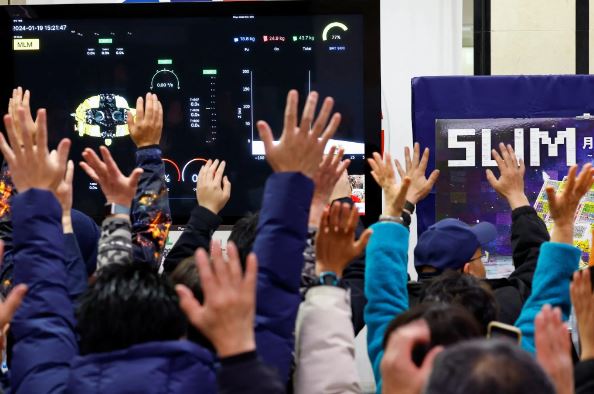In a significant achievement, a Japanese robotic spacecraft, the Smart Lander for Investigating Moon (SLIM), successfully made a soft landing on the moon. While this makes Japan the fifth country to achieve a lunar landing, the spacecraft encountered challenges as its solar panels failed to generate power. The landing, managed by Japan’s space agency, JAXA, aimed to demonstrate precision landing capabilities within a narrow target area and enhance the country’s expertise in lunar exploration.
The landing occurred at 10:20 a.m. Eastern time on Friday, with SLIM touching down near a small crater named Shioli on the moon’s equatorial region. The surface presented a 15-degree angle, posing challenges for a stable landing. The spacecraft’s designers implemented a tilting strategy to prevent tipping during the landing, successfully executing the soft landing within the targeted vicinity.
While SLIM immediately transmitted signals back to Earth after landing, the status of the mission remained uncertain due to issues with its solar panels. The solar panels were not generating power, which could limit the spacecraft’s operational time to a few hours. Despite the setback, JAXA officials expressed optimism, suggesting that the panels might be incorrectly oriented, and sunlight at a different angle could potentially resolve the issue.
The soft landing met the minimal requirements for mission success, and further analysis will determine how close SLIM landed to the targeted site. The spacecraft’s battery is currently sustaining its operation, with energy conservation measures implemented, such as turning off heaters.
SLIM’s mission included the deployment of two small rovers, Lunar Excursion Vehicle 1 (LEV-1) and Lunar Excursion Vehicle 2 (LEV-2). LEV-1 utilized a hopping mechanism and carried instruments to measure temperature, radiation, slope, and elevation. LEV-2, a spherical rover about the size of a baseball, was designed to crawl along the lunar surface for a limited time.
JAXA developed image-processing algorithms to overcome limitations posed by space-grade computer chips, which are typically less powerful than commercial chips due to radiation hardening. SLIM utilized radar pings and vision-based systems to determine its altitude, speed, and location, navigating and avoiding obstacles during its descent.
Despite the solar panel challenge, data from the two rovers were successfully transmitted back to Earth. LEV-1 communicated directly with Earth, while LEV-2 communicated through LEV-1. The limited operational time of the spacecraft due to the solar panel issue prompted mission managers to prioritize the retrieval of navigation data acquired during the landing.
Over the past 11 years, several spacecraft have been sent to the moon, with varying degrees of success. China remains the only country with a perfect record, achieving three successful robotic spacecraft landings on the moon. Other attempts, including those by Russia, a Japanese private company, and an Israeli nonprofit, have faced challenges or failures.
Despite the solar panel setback, Japan continues to pursue lunar exploration initiatives. The country is collaborating with India on launching a robotic rover, LUPEX, potentially next year, and Japanese astronauts may participate in future lunar missions as part of NASA’s Artemis program.
while SLIM’s soft landing on the moon represents a notable achievement for Japan, the solar panel issue poses operational challenges. The mission’s success in demonstrating precision landing capabilities contributes to advancements in lunar exploration technology, with potential applications for future missions, including those aligned with international space programs like NASA’s Artemis.

